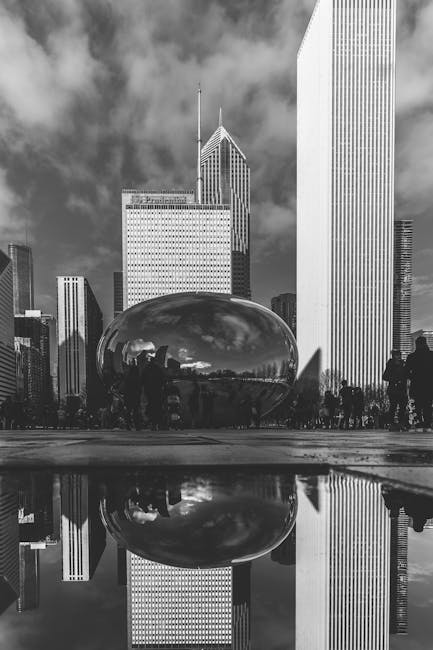The Evolution of Chicago’s Skyline: A Century in Architecture
Chicago, often referred to as the “Windy City,” is renowned for its architectural prowess and stunning skyline. Over the past century, the city has witnessed a transformative journey in architecture, evolving from humble beginnings to a landscape dotted with iconic skyscrapers. This blog post explores the fascinating evolution of Chicago’s skyline, highlighting key developments and architectural marvels that have shaped its horizon.
Table of Contents
1. Introduction
2. The Birth of the Skyscraper
3. The Rise of Art Deco
4. Post-War Modernism
5. The Contemporary Era
6. Conclusion
7. FAQs
The Birth of the Skyscraper
Chicago’s skyline story begins in the late 19th century, a period marked by rapid urban growth and technological innovation. The 1880s and 1890s saw the emergence of the skyscraper, a revolutionary architectural concept at the time. The Home Insurance Building, completed in 1885, is often regarded as the world’s first skyscraper. Although it stood at a modest 10 stories, it set the stage for future architectural advancements.
As steel-frame construction became more prevalent, architects in Chicago pushed the boundaries of vertical expansion. The Monadnock Building and the Rookery are prime examples of this era’s ingenuity, showcasing a blend of traditional styles with pioneering structural techniques. These early skyscrapers were not just functional but also aesthetically pleasing, featuring intricate facades and ornamental details.
The Rise of Art Deco
The 1920s and 1930s ushered in the Art Deco movement, leaving a lasting impact on Chicago’s architectural landscape. This period was characterized by bold geometric shapes, lavish decorations, and a sense of luxury. The Chicago Board of Trade Building, completed in 1930, is a quintessential Art Deco masterpiece with its striking setbacks and stylized sculptures.
During this time, architects embraced new materials and design philosophies, resulting in buildings that exuded elegance and sophistication. The Carbide & Carbon Building, with its dark green terra cotta and gold leaf accents, is a testament to the opulence and grandeur of the Art Deco era. These structures contributed to the city’s skyline by introducing height variations and a distinct visual rhythm.
Post-War Modernism
After World War II, Chicago experienced another architectural renaissance as the city embraced modernism. The International Style, characterized by clean lines and functional forms, became the dominant architectural language. Ludwig Mies van der Rohe, a leading figure in modern architecture, left an indelible mark on the city with his minimalist designs.
One of Mies van der Rohe’s most notable contributions is the iconic 860–880 Lake Shore Drive Apartments. These glass-and-steel residential towers epitomize the modernist ethos of simplicity and transparency. The Willis Tower (formerly Sears Tower), completed in 1973, was another milestone, standing as the world’s tallest building for nearly 25 years. Its innovative bundled-tube structure demonstrated the potential of modern engineering and design.
The Contemporary Era
In recent decades, Chicago’s skyline has continued to evolve, embracing contemporary styles and sustainability practices. The city is home to a diverse array of skyscrapers that reflect global architectural trends. The Aqua Tower, designed by Jeanne Gang, is a standout for its undulating balconies and integration with the urban environment.
The addition of the St. Regis Chicago, with its distinctive glass facade and organic form, has further enriched the skyline. This era of architecture emphasizes not only aesthetics but also environmental responsibility, with many buildings incorporating green technologies and sustainable materials.
Conclusion
Chicago’s skyline is a testament to the city’s resilience, creativity, and forward-thinking spirit. From the early days of the skyscraper to the modern marvels of today, each era has left its mark, creating a dynamic and ever-changing urban silhouette. As we look to the future, one can only imagine the innovations and architectural wonders that await this iconic city.
FAQs
Q: Which building is considered the first skyscraper in Chicago?
A: The Home Insurance Building, completed in 1885, is widely regarded as the first skyscraper in Chicago and the world.
Q: What is the tallest building in Chicago today?
A: As of now, the Willis Tower holds the title of the tallest building in Chicago.
Q: How has sustainability influenced recent architecture in Chicago?
A: Recent architecture in Chicago often incorporates sustainable practices, such as energy-efficient systems and eco-friendly materials, as seen in buildings like the Aqua Tower and St. Regis Chicago.
From the birth of the skyscraper to the innovative designs of today, Chicago’s skyline remains a symbol of architectural excellence and a source of inspiration for architects worldwide. 🌆🏗️


